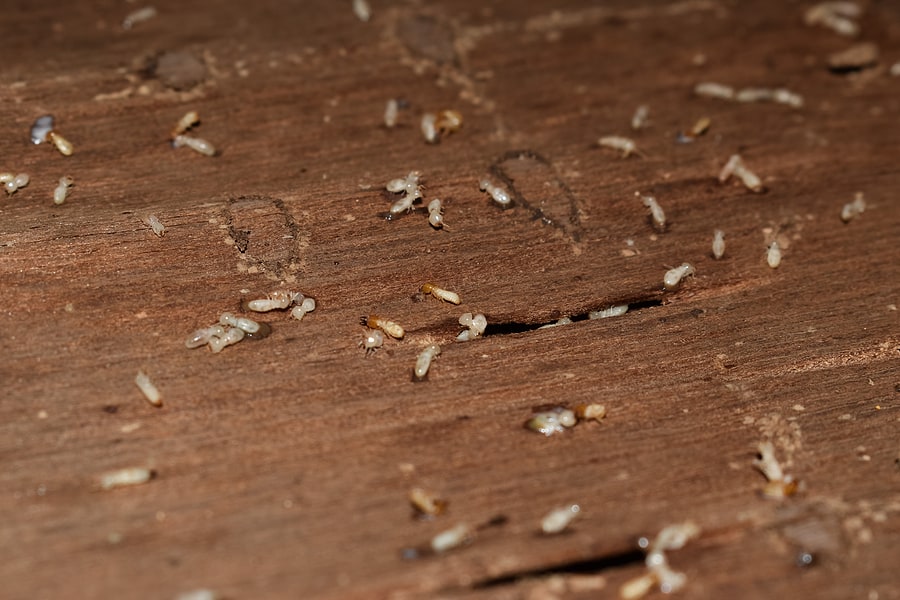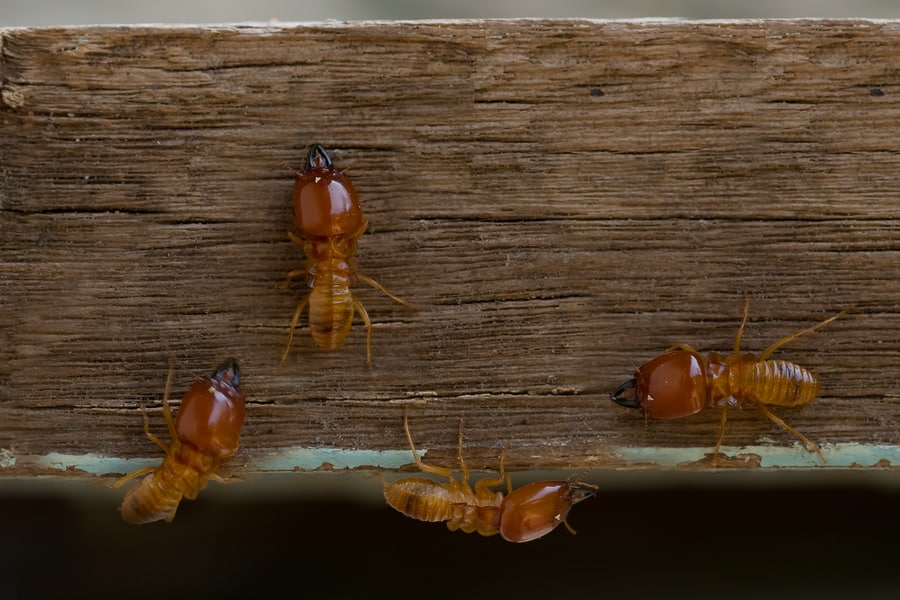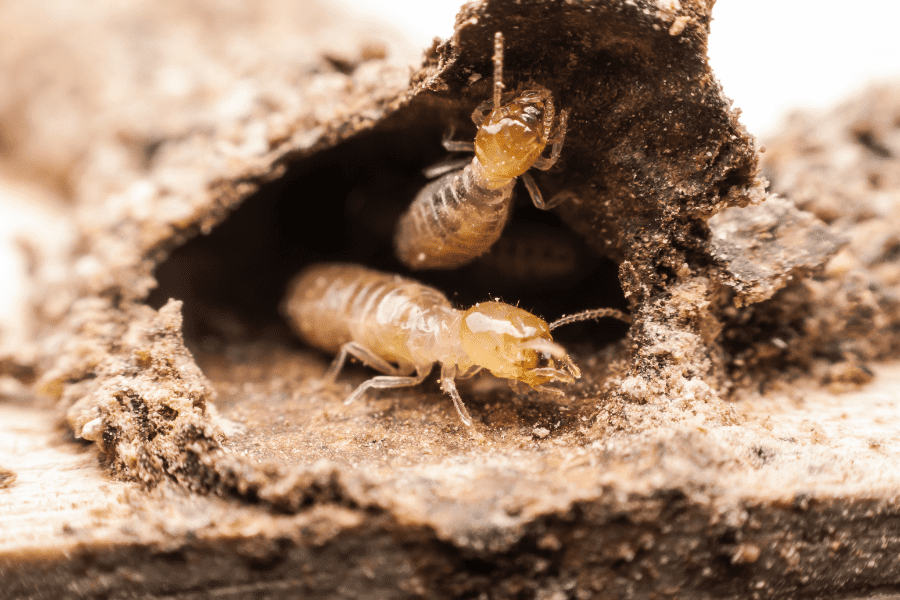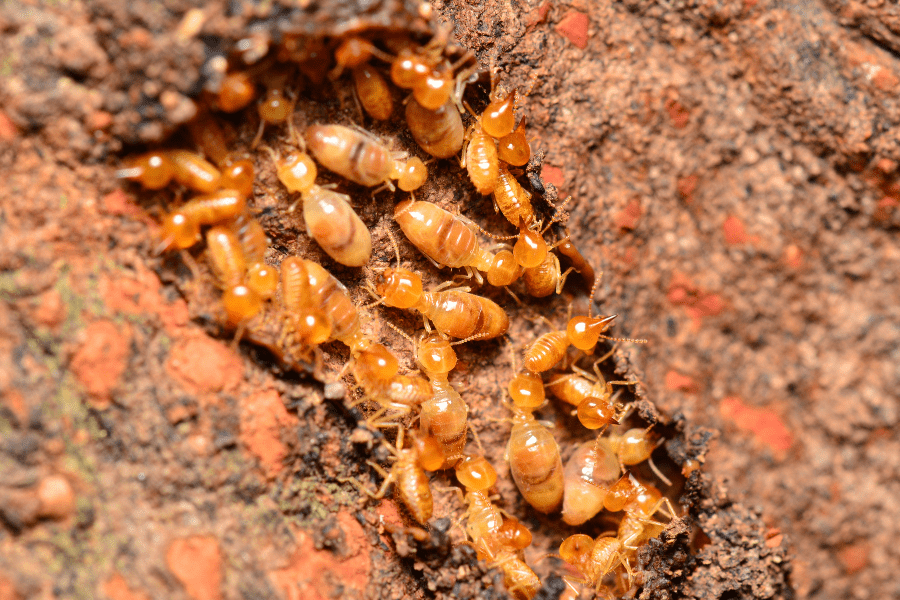READY TO GET STARTED?
REQUEST A FREE ESTIMATE
Fill out the form below or call (888) 466-7849 for a free, no-obligation estimate.

Termites will not stop until they find a food source for their colony, often destroying our homes in the process. A termite infestation can be devasting, as their damage can cost billions of dollars in repair. One of the best ways to avoid their damage is investing in termite control for your Alabama home. Let’s review the signs of termites and the several types of termite treatment options available so you can avoid their devastation.
Termites are silent destroyers, meaning they can go unnoticed for extended periods. However, there are many ways that you can tell you have a termite infestation.
When investing in termite treatment and prevention options, there are three common types of professional treatments that every homeowner should know, including bait stations, liquid-soil treatments, and wood treatments.
If you’re interested in these termite treatment options, consider contacting your local pest control company for more information. These professionals can provide you with a comprehensive inspection and help determine the best termite control plan for you and your home.

Discovering termites in your Tennessee home can be a concerning thought. Each year, termites cause billions of dollars’ worth of damage to homeowners. Don’t let your home fall under this statistic. We have all the information you need to begin termite prevention now.
Termites can’t level your home within a week or within five years, but over time they will eat away at your home from the inside out. They are difficult to spot and are incredibly quiet destroyers. The earliest signs of termite damage can be seen within months of them infiltrating your home.
One way to avoid property damage from termites is to have your home inspected once or twice a year. The best way to prevent termites is to have long-term termite control in place.
In the meantime, here are some DIY termite prevention methods you can do today:
Are you ready for long-term termite prevention in your Tennessee home? Give your local pest control company a call today and receive a free inspection to begin keeping termites away!
Spring brings warm weather and the need for spring cleaning. When making your spring to-do list, make sure to include pest control with it. The warm weather brings pests out in droves, whether emerging from their overwintering spots or searching for a mate to reproduce with. One of the most common spring pests are termites. Spring marks the beginning of termite swarming season, when termites leave their colonies in search of a mate to form a new colony with. Don’t forget to make termite treatment a priority on your spring checklist!
Termites can go undetected for long periods of time, causing significant damage to your home. Once you identify the signs of termites, the next step is to determine the best termite treatment for your situation. Here are some of the most common termite treatment options:
Pretreatments are termite treatments carried out during the construction phase of new construction. It is also preferable to use pretreatments when building additions to an existing home. When used before the physical infrastructure of a home or addition is laid, pretreatments are more effective and cost-effective. Pretreatments typically consist of a combination of liquid termiticide (often containing borates), termite bait, lumber treatment, and in-soil barriers.
Barrier treatments create a physical barrier between termites and your home. A trench is dug around your home’s perimeter, and the soil that is removed is heavily treated with a termiticide. The treated soil is then refilled into the trench. In some cases, a physical wall made of rock, sand, mesh, and plastic is built inside the trench’s outer wall. This adds another layer of defense between your home and termites.
The most common termite treatments are liquid treatments. These treatments are effective for termite infestations in your home’s interior. Holes are strategically drilled in both the foundation and the wood in these treatments. The termites are then forced to emerge after termiticide is injected into the holes. Termites are then exterminated using termiticide spot treatments.
Bait stations containing termiticide-laced wood, paper, or cellulose are placed in the ground around your home. Termites are drawn to the bait and consume it. The termiticide is slow acting, allowing termites to return to the colony and spread the bait to others, effectively killing the colony. Bait stations can be used in places where surface treatments cannot be used, such as near foundation drains and areas covered by slabs or flooring. Bait stations are a long-term and effective treatment solution.
While it can be tempting to attempt termite control yourself, it is usually best left to the professionals. If you have a termite infestation, contact your local pest control company for a termite inspection to determine the best treatment options for your home.
How to Manage Your Lawn & Prevent Lawn Diseases

Termites are known as silent destroyers, meaning they can go undetected for a long period of time, making their destruction devasting. Common termite species, such as subterranean termites, will infest our Augusta homes and damage the infrastructure, costing billions of dollars in repair. It can be difficult to detect subterranean termites, often hiding until the damage is done, but it is possible. To prevent termites, every homeowner should recognize signs of termite infestations. Check out our top 5 signs of termites that you might see in your home:
Often found on exterior surfaces, subterranean termites create mud tubes that allow them to move back and forth between their nest and their food source, which is often your home. These tunnels help protect termites from any predators and provide moisture for survival. Usually, mud tubes can be found wrapped around walls, ceilings, and floors. Mud tubes are common signs of termites.
Sometimes, hearing noises is your first sign of a termite infestation. Often, if a termite colony has infested your home, you can hear a faint clicking or knocking sound coming from behind walls and other voids. Termites create this noise when a soldier termite bangs their head against wood or vibrates their bodies to signal damage to their colony. When you listen closely, you can also hear termites chewing through wood.
Have you noticed hollow wood inside your home or in trees throughout your yard? If so, this is a major sign that termites have established a colony on your property. These pests destroy wood from the inside out, leaving only a thin layer of wood behind. When checking for hollow wood, try tapping on the area in question. You’ll hear a hollow or paper sound, indicating an infestation. Other signs include blistering or bubbling paint in or near wood structures, including windows and door trims.
Frass is the name for the waste termites leave behind. When subterranean termites travel through wood, they will push debris and waste out behind them through tiny openings. You may notice small black marks or a dark powdery substance around the infested area with small piles of sawdust-like droppings. These sawdust droppings are frass and are usually the color of the structural wood infested.
The most obvious sign of a termite infestation is seeing the damaged wood itself. Floor, window, and door damage is a major indication that termites are inside. Another indication includes windows and doors not opening or closing smoothly. Take note of any floors that buckle or sag and have them inspected.
If you’ve noticed any of these termite signs or damage, consider contacting your pest control company for a thorough inspection and treatment plan before any more termite damage is done.

Spring is a crucial time for identifying and dealing with termites because it’s the season for swarming. Swarming termites are a big indicator that a termite colony is nearby, which could mean an infestation is occurring. It’s better to discover you have termites earlier than later, due to the significant damage they can cause to your home.
Swarming termites are winged adult termites that mature and fly away from their colonies to continue reproducing. Termite swarming begins at different times of the year depending on the type of termite, but they all usually begin when the weather begins warming up following a significant rain event. The one type of termite that typically swarms first is known as subterranean termites.
Because termites eat wood from the inside out, termite damage often goes undetected for long periods of time. Often in fact, by the time signs of termites appear, colonies are well established, and significant damage has already been done. If you begin spotting swarming termites, keep an eye out for other signs of termites, like these below:
If you suspect you have a termite problem or if you spot signs of a termite infestation, contact a professional termite control company who can provide you with a thorough termite inspection and a comprehensive termite protection and treatment plan.